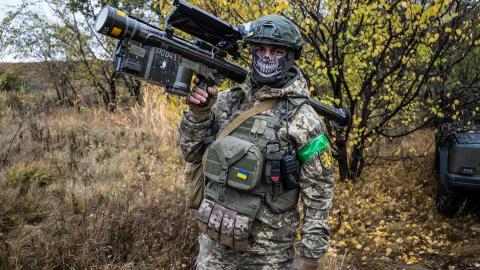Below Senior Fellow Can Kasapoğlu offers a military situation report about the war in Ukraine.
Executive Summary
• Thousands of North Korean troops are set to deploy alongside Russian combat formations in Ukraine, raising alarms in North Atlantic Treaty Organization capitals.
• In the Russian region of Kursk, the Kremlin’s 155th Marine Brigade executed Ukrainian prisoners of war.
• Ukraine launched successful strikes against several targets inside Russia.
1. A New Enemy at the Gates: The North Korean Military on the Ground in Europe
Further evidence has emerged that North Korea’s support of Russia’s invasion of Ukraine has extended beyond ammunition transfers and diplomatic support, and now involves North Korean troops in Europe.
On October 21, South Korean President Yoon Suk Yeol participated in a telephone conversation at the request of NATO Secretary General Mark Rutte. The two leaders exchanged critical intelligence on North Korean combat formations within the Russian military and the formations’ potential roles in the war. South Korea also summoned Georgy Zinoviev, Russia’s ambassador to Seoul, to protest the troubling new ties between Pyongyang and Moscow. South Korea’s demand that North Korea immediately withdraw its troops underscored the urgency of the situation.
General Kyrylo Budanov, the chief of Ukraine’s Main Directorate of Intelligence (GUR), revealed that a division-size North Korean force of approximately 11,000 servicemen is currently training in Russia to prepare for deployment in Ukraine. Of these personnel, a regiment-size unit of 2,600 troops is reportedly soon heading to the Russian region of Kursk. Intelligence from South Korea, which aligns with reports from Ukraine, detected the presence of training facilities in Russia capable of accommodating up to 12,000 North Korean servicemen. South Korean officials also disclosed that Pyongyang has dispatched a 1,500-person special forces detachment to Russia, further highlighting the scale of North Korea’s commitment.
North Korea’s involvement has given a significant boost to Russia’s effort in Ukraine. Some intelligence assessments have concluded that half of the three million artillery shells the Russian military has used yearly in Ukraine have come from Pyongyang. Furthermore, a technical analysis of a North Korean KN-23 short-range ballistic missile recently shot down in Ukraine has revealed that Pyongyang’s munition uses components from Western systems. In return for this support, Moscow has rewarded Pyongyang with technical assistance for its own weapons systems. Cooperation between Russia and North Korea is a dangerous trend that this report will continue to monitor.
2. Battlefield Assessment
Russian forces continued offensive efforts on the Kharkiv front, where they launched waves of attacks to capture the critical hub of Vovchansk.
Elite Russian combat formations, including detachments from the 1st Guards Tank Army and special operations units from the Main Directorate of the General Staff of the Armed Forces (GRU), participated in the fighting. Kupiansk has also seen heavy combat that has increased pressure on Ukraine. Furthermore, declassified intelligence from the United Kingdom’s Ministry of Defence revealed that Russian combat formations have reached the Oskil River. The September 25, 2024, edition of this report highlighted how the Oskil could provide the Russian General Staff with a natural barrier to stabilize the front and cement its territorial gains.
Additionally, the Russian military intensified offensive combat action around the Ukrainian town of Chasiv Yar. Pokrovsk and Toretsk also remain under heavy pressure, with Ukrainian defensives wavering there. Visual evidence shows that the Ukrainian military has combat-deployed sub-units of the 38th Marine Brigade to the Pokrovsk front.
Meanwhile, the 36th Ukrainian Marine Brigade continued to operate in the Russian region of Kursk. Open-source intelligence suggests that the Ukrainian military has fielded Abrams main battle tanks, its principal high-end Western armor, as well as Bradley infantry fighting vehicles in its Kursk campaign. After bolstering its force-on-force and force-to-terrain ratios in Kursk, the Russian military has been on a counteroffensive footing for several weeks. Unfortunately, evidence is mounting that Russia’s 155th Marine Brigade, infamous for conducting massacres in the Ukrainian cities of Bucha and Irpin in the early stages of the war, has again committed war crimes, killing several Ukrainian prisoners of war (POWs) in Kursk.
The Ukrainian military continued to conduct long-range strikes to attempt to gain an asymmetric advantage in the face of Russia’s conventional superiority on land. Last week, Ukraine’s drones hammered the Russian state-owned Sverdlov plant, one of Russia’s largest manufacturers of military explosives, near Nizhny Novgorod over 450 miles inside Russia. Kyiv’s drone and missile forces also struck the Lipetsk-2 military airport, located 240 miles from the Ukrainian front. The Ukrainian General Staff reported that the salvo targeted ammunition depots and fuel storage centers that supply Russia’s Su-35 fighters, MiG-31 interceptors, and Su-34 fighter-bombers. Ukraine also used American-provided High Mobility Artillery Rocket Systems (HIMARS) to pound a Russian military training ground on the southern front.




















